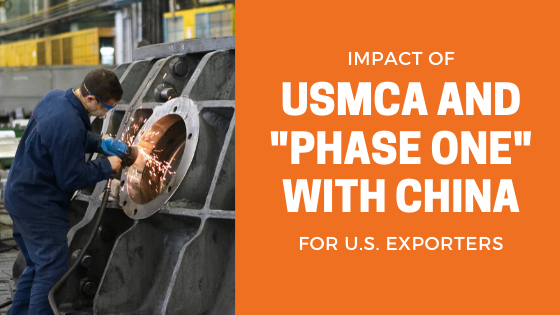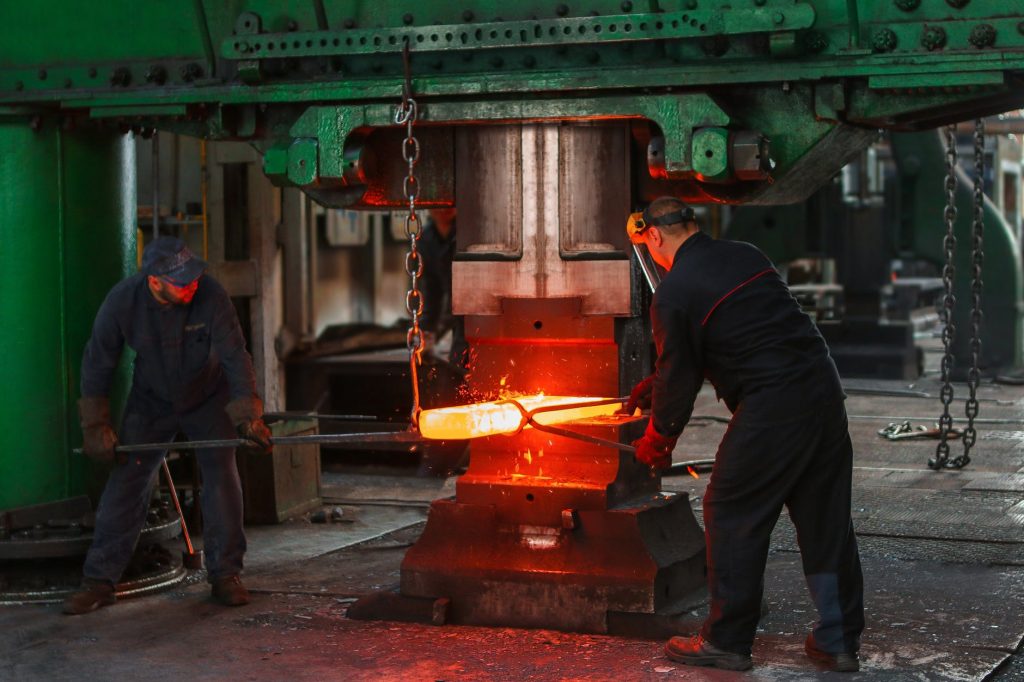Posted with permission from greatamericaninsurancegroup.com Overview The global economy faces several uncertainties in...

What the Recent Trade Deals Mean for Exporters
Trade Policy Actions Offer Possibilities for Exporters
In the previous week, two trade policy announcements signaled movement on key trade priorities of the Trump Administration. Both the renegotiation of the North American Free Trade Agreement (NAFTA), now called the US-Mexico-Canada Agreement or USMCA, and the tentative “Phase One” trade agreement between the US and China came closer to finality last week. Both have the potential to bring about changes in 2020 that could benefit US exporters.
First, on Tuesday, December 10, after months of re-negotiation, the USMCA cleared the last hurdle to US ratification with Congressional negotiators signaling support for a revised draft.
The new draft revises the agreement originally signed by leaders of the three countries in November 2018 and notably includes stronger enforcement measures for worker rights and environmental protections, as well revisions to patent protections for certain pharmaceuticals.
Only a few days later on Friday, December 13, US Trade Representative (USTR) Robert Lighthizer announced completion of negotiations with Chinese counterparts on an “enforceable” first-stage trade agreement with China, mainly covering key areas of agriculture, technology, intellectual property, and financial services. The agreement stalls an anticipated round of new tariffs on Chinese goods that were set to go into effect on December 15.
USMCA Seeks Stability, Fairness
Efforts to press Mexico for enforceable actions on worker rights and wages, underscore negotiators efforts to create a more level playing field for US manufacturing. Critics of the 1994 NAFTA agreement claimed it incentivized manufacturing offshoring to Mexico, and failed to improve Mexican incomes and buying power.
In auto manufacturing specifically, the new deal will mandate an increase in the percentage of a vehicle’s value that must be sourced in North American (75%, up from 62.5%), the amount of North American steel and aluminum that must be used (70%), and the percentage of a vehicle’s value must be made by workers making at least $16 an hour.
Despite the new regulations, the American Automotive Policy Council, which represents the Big Three automakers, praised the deal, noting that it “will incentivize a $23 billion increase in US annual parts sales alone.”
As Canada and Mexico are the largest export markets for US agricultural goods, the agreement offers some stability for the sector. With many Canadian and Mexican tariffs set to end in the new agreement, American producers, specifically in the pork and dairy sectors, are set to benefit.
The agreement ends a period of trade discord between the three countries. With recent tit-for-tat tariffs set to end and an agreement likely ratified, the USMCA will offer US businesses greater policy stability and a favorable environment for increasing trade flows in 2020.
Overall, a US International Trade Commission report completed earlier this year estimated that the USMCA would increase US exports to Canada by 19.1 billion or 5.9% and to Mexico by $14.2 billion or 6.7%.
China Agreement a First Step
The US-China agreement comes after nearly two years of disagreement over trade, and is being hailed by the US side as an initial step toward an overall effort to reach final comprehensive trade agreement in the future. For its part, the US agreed to lower tariffs on an estimated $360 billion in goods from China, and cancelled tariffs on roughly $160 billion worth of consumer goods that were set to go into effect last weekend.
China agreed in return to cancel planned retaliatory tariffs on over 3,000 American products while agreeing to several concessions, such as a promise to stop requiring US companies to hand over proprietary technology to enter the Chinese market. China has also agreed to buy $50 billion in agricultural products in 2020 and agreed to an additional increase in overall US exports of $200 billion over the next two years. For example, in 2018, China purchased $9.3 billion in US agricultural products, and an overall total of $120.3 billion in US goods and services.
The US will keep 25% tariffs on a separate list of Chinese goods in place to be discussed in future follow-on negotiations.
US importers, particularly in the computer and retail industries will immediately benefit from the halting of expected new tariffs, which were set to hit Chinese-made electronics, toys, and garments. For US exporters, the details of China’s pledge to increase purchases of US products remains to be worked out with initial language from the USTR noting broadly that increases will include “manufactured goods, food, agricultural and seafood products, energy products, and services.”
US soybean and pork sales are expected to increase, while US auto parts manufacturers will not be impacted by planned retaliatory tariffs that have now been called off by China. Leading US exports to China include soybeans, integrated electronic circuits, automobiles, and aircraft. Importantly, China also has agreed in general to a number of provisions to improve the overall environment of doing business in the country, including improved respect for intellectual property and removal of many existing barriers to its financial services sector.
While these promises are worth noting, China’s record on maintaining its economic commitments are questionable, at best. USTR has noted that new agreement will be “totally enforceable,” details will become more available as the final text is worked out between the two countries.
Exporting to Mexico, Canada, China: Tools for Exporters
Both trade agreements will hopefully introduce more certainty into cross-border trade and lead to increasing opportunities for US exporters.
The International Trade Administration (ITA), the U.S. Department of Commerce’s export promotion agency (www.export.gov) offers a range of services from general information about trade, to more detailed market and product data, to seminars and promotional events highlighting U.S. products. The US Commercial Service (USCS) can further provide companies with more tailored and detailed counseling and services – particularly small and medium-sized enterprises. The USCS can be accessed at www.export.gov/locations while its Philadelphia office is at https://2016.export.gov/pennsylvania/philadelphia/.
For More Analysis of Both Agreements See the Following Sources:
USMCA
USTR Fact Sheet on USMCA; and USTR Industry Specific Fact Sheets
Wall Street Journal, “From Farms to Silicon Valley, U.S. Businesses Stand to Gain From USMCA,” December 10, 2019
Washington Post, “The USMCA is finally done. Here’s what is in it.” December 10, 2019
US – China “Phase One” Agreement
USTR Fact Sheet
Wall Street Journal, “U.S., China Agree to Limited Deal to Halt Trade War,” December 14, 2019
Reuters, “Factbox: What is actually in the U.S.-China ‘Phase One’ trade deal?,” December 16, 2019
About Securitas
Securitas Global Risk Solutions aids current and potential exporters through political risk and trade credit insurance, as well as a range of financial solutions to help clients protect their foreign sales, increase cash flows, and access global markets more securely and aggressively.
Based in the Philadelphia area, the team at Securitas is prepared to work with clients to understand their export goals and structure affordable risk solutions. Securitas Global Risk Solutions is located at 900 West Valley Road, Suite 701, Wayne, PA 19087, by phone at 484-595-010, and at www.securitasglobal.com
Recommended News
Major Country Risk Developments January 2023
Aircraft Lessors Sue Insurance Companies for Coverage in Russian Confiscation Debacle
Carlyle Aviation Partners' lawsuit against insurers The lawsuit was filed on October 31 against over 30 insurers in...
The Sudden Bankruptcy Filing of Vital Pharmaceuticals Inc / Bang Energy
Could a Large Manufacturer be a Credit Risk? Vital Pharmaceuticals is the third largest energy drink manufacturer in...





